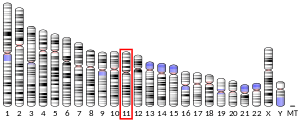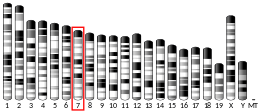Kir6.2
Kir6.2 is a major subunit of the ATP-sensitive K+ channel, a lipid-gated inward-rectifier potassium ion channel.[5] The gene encoding the channel is called KCNJ11 and mutations in this gene are associated with congenital hyperinsulinism.[6]
Structure
It is an integral membrane protein. The protein, which has a greater tendency to allow potassium to flow into a cell rather than out of a cell, is controlled by G-proteins and is found associated with the sulfonylurea receptor (SUR) to constitute the ATP-sensitive K+ channel.
Pathology
Mutations in this gene are a cause of familial persistent hyperinsulinemic hypoglycemia of infancy (PHHI), an autosomal recessive disorder characterized by unregulated insulin secretion. Defects in this gene may also contribute to autosomal dominant non-insulin-dependent diabetes mellitus type II (NIDDM).[5][7]
See also
- Inward-rectifier potassium ion channel
- Potassium channel
References
- GRCh38: Ensembl release 89: ENSG00000187486 - Ensembl, May 2017
- GRCm38: Ensembl release 89: ENSMUSG00000096146 - Ensembl, May 2017
- "Human PubMed Reference:". National Center for Biotechnology Information, U.S. National Library of Medicine.
- "Mouse PubMed Reference:". National Center for Biotechnology Information, U.S. National Library of Medicine.
- "Entrez Gene: KCNJ11 potassium inwardly-rectifying channel, subfamily J, member 11".
- Smith AJ, Taneja TK, Mankouri J, Sivaprasadarao A (2007). "Molecular cell biology of KATP channels: implications for neonatal diabetes". Expert Rev Mol Med. 9 (21): 1–17. doi:10.1017/S1462399407000403. PMID 17666135.
- Koo BK, Cho YM, Park BL, Cheong HS, Shin HD, Jang HC, Kim SY, Lee HK, Park KS (2007). "Polymorphisms of KCNJ11 (Kir6.2 gene) are associated with Type 2 diabetes and hypertension in the Korean population". Diabet. Med. 24 (2): 178–86. doi:10.1111/j.1464-5491.2006.02050.x. PMID 17257281.
Further reading
- Aguilar-Bryan L, Bryan J (1999). "Molecular biology of adenosine triphosphate-sensitive potassium channels". Endocr. Rev. 20 (2): 101–35. doi:10.1210/er.20.2.101. PMID 10204114.
- Meissner T, Beinbrech B, Mayatepek E (1999). "Congenital hyperinsulinism: molecular basis of a heterogeneous disease". Hum. Mutat. 13 (5): 351–61. doi:10.1002/(SICI)1098-1004(1999)13:5<351::AID-HUMU3>3.0.CO;2-R. PMID 10338089.
- Kubo Y, Adelman JP, Clapham DE, et al. (2006). "International Union of Pharmacology. LIV. Nomenclature and molecular relationships of inwardly rectifying potassium channels". Pharmacol. Rev. 57 (4): 509–26. doi:10.1124/pr.57.4.11. PMID 16382105.
- Gloyn AL, Siddiqui J, Ellard S (2006). "Mutations in the genes encoding the pancreatic beta-cell KATP channel subunits Kir6.2 (KCNJ11) and SUR1 (ABCC8) in diabetes mellitus and hyperinsulinism". Hum. Mutat. 27 (3): 220–31. doi:10.1002/humu.20292. PMID 16416420.
- Flechtner I, de Lonlay P, Polak M (2007). "Diabetes and hypoglycaemia in young children and mutations in the Kir6.2 subunit of the potassium channel: therapeutic consequences". Diabetes Metab. 32 (6): 569–80. doi:10.1016/S1262-3636(07)70311-7. PMID 17296510.
- Inagaki N, Gonoi T, Clement JP, et al. (1996). "Reconstitution of IKATP: an inward rectifier subunit plus the sulfonylurea receptor". Science. 270 (5239): 1166–1170. doi:10.1126/science.270.5239.1166. PMID 7502040.
- Thomas PM, Cote GJ, Hallman DM, Mathew PM (1995). "Homozygosity mapping, to chromosome 11p, of the gene for familial persistent hyperinsulinemic hypoglycemia of infancy". Am. J. Hum. Genet. 56 (2): 416–21. PMC 1801118. PMID 7847376.
- Iwasaki N, Kawamura M, Yamagata K, et al. (1996). "Identification of microsatellite markers near the human genes encoding the beta-cell ATP-sensitive K+ channel and linkage studies with NIDDM in Japanese". Diabetes. 45 (2): 267–9. doi:10.2337/diabetes.45.2.267. PMID 8549873.
- Sakura H, Wat N, Horton V, et al. (1997). "Sequence variations in the human Kir6.2 gene, a subunit of the beta-cell ATP-sensitive K-channel: no association with NIDDM in while Caucasian subjects or evidence of abnormal function when expressed in vitro". Diabetologia. 39 (10): 1233–1236. doi:10.1007/BF02658512. PMID 8897013.
- Thomas P, Ye Y, Lightner E (1997). "Mutation of the pancreatic islet inward rectifier Kir6.2 also leads to familial persistent hyperinsulinemic hypoglycemia of infancy". Hum. Mol. Genet. 5 (11): 1809–1812. doi:10.1093/hmg/5.11.1809. PMID 8923010.
- Inoue H, Ferrer J, Warren-Perry M, et al. (1997). "Sequence variants in the pancreatic islet beta-cell inwardly rectifying K+ channel Kir6.2 (Bir) gene: identification and lack of role in Caucasian patients with NIDDM". Diabetes. 46 (3): 502–7. doi:10.2337/diabetes.46.3.502. PMID 9032109.
- Tucker SJ, Gribble FM, Zhao C, et al. (1997). "Truncation of Kir6.2 produces ATP-sensitive K+ channels in the absence of the sulphonylurea receptor". Nature. 387 (6629): 179–83. doi:10.1038/387179a0. PMID 9144288.
- Halushka MK, Fan JB, Bentley K, et al. (1999). "Patterns of single-nucleotide polymorphisms in candidate genes for blood-pressure homeostasis". Nat. Genet. 22 (3): 239–47. doi:10.1038/10297. PMID 10391210.
- Tucker SJ, Ashcroft FM (1999). "Mapping of the physical interaction between the intracellular domains of an inwardly rectifying potassium channel, Kir6.2". J. Biol. Chem. 274 (47): 33393–7. doi:10.1074/jbc.274.47.33393. PMID 10559219.
- Cui Y, Giblin JP, Clapp LH, Tinker A (2001). "A mechanism for ATP-sensitive potassium channel diversity: Functional coassembly of two pore-forming subunits". Proc. Natl. Acad. Sci. U.S.A. 98 (2): 729–34. doi:10.1073/pnas.011370498. PMC 14656. PMID 11136227.
- Giblin JP, Cui Y, Clapp LH, Tinker A (2002). "Assembly limits the pharmacological complexity of ATP-sensitive potassium channels". J. Biol. Chem. 277 (16): 13717–23. doi:10.1074/jbc.M112209200. PMID 11825905.
- Crawford RM, Budas GR, Jovanović S, et al. (2002). "M-LDH serves as a sarcolemmal K(ATP) channel subunit essential for cell protection against ischemia". EMBO J. 21 (15): 3936–3948. doi:10.1093/emboj/cdf388. PMC 126135. PMID 12145195.
- Tschritter O, Stumvoll M, Machicao F, et al. (2002). "The prevalent Glu23Lys polymorphism in the potassium inward rectifier 6.2 (KIR6.2) gene is associated with impaired glucagon suppression in response to hyperglycemia". Diabetes. 51 (9): 2854–2860. doi:10.2337/diabetes.51.9.2854. PMID 12196481.
External links
- GeneReviews/NCBI/NIH/UW entry on Familial Hyperinsulinism
- GeneReviews/NCBI/NIH/UW entry on Permanent Neonatal Diabetes Mellitus
- KCNJ11+protein,+human at the US National Library of Medicine Medical Subject Headings (MeSH)
- SUR1+protein,+human at the US National Library of Medicine Medical Subject Headings (MeSH)
This article incorporates text from the United States National Library of Medicine, which is in the public domain.



